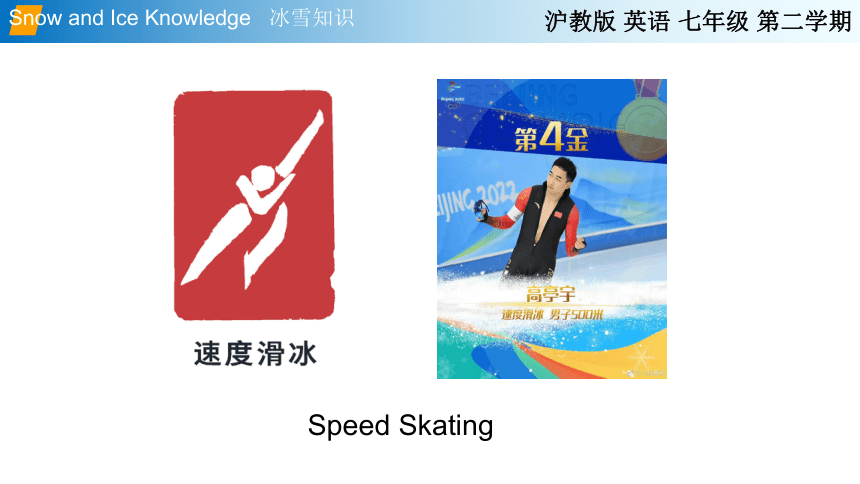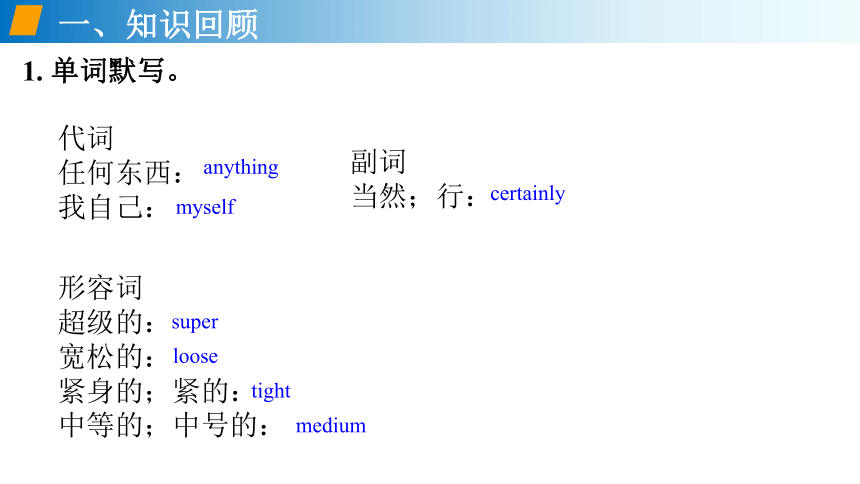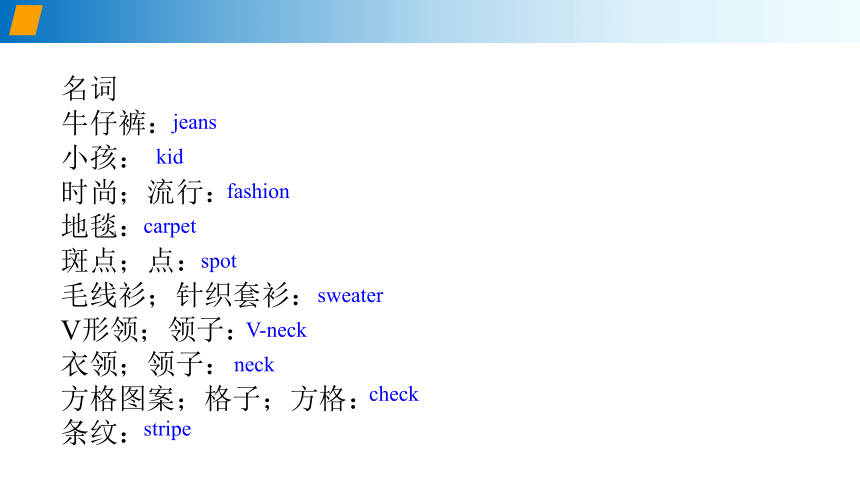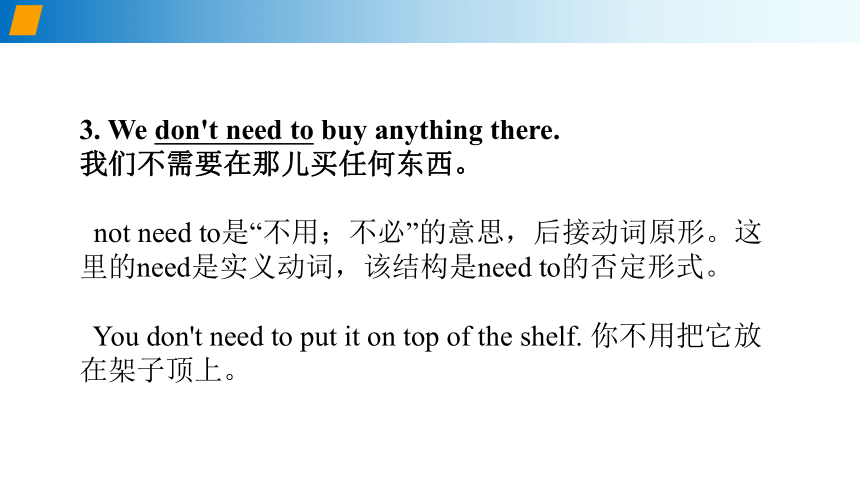Unit4 Let’s go shopping 第2课时 语法知识及拓展 课件(共24张PPT)
文档属性
| 名称 | Unit4 Let’s go shopping 第2课时 语法知识及拓展 课件(共24张PPT) |  | |
| 格式 | pptx | ||
| 文件大小 | 519.8KB | ||
| 资源类型 | 试卷 | ||
| 版本资源 | 牛津上海版(试用本) | ||
| 科目 | 英语 | ||
| 更新时间 | 2022-03-09 18:27:46 | ||
图片预览









文档简介
(共24张PPT)
Lead in— 脑筋急转弯
Q:什么东西使人哭笑不得?
A:口罩
沪教版 英语 七年级 第二学期
Snow and Ice Knowledge 冰雪知识
Speed Skating
沪教版 英语 七年级 第二学期
一、知识回顾
1. 单词默写。
代词
任何东西:
我自己:
myself
anything
形容词
超级的:
宽松的:
紧身的;紧的:
中等的;中号的:
super
loose
tight
medium
副词
当然;行:
certainly
名词
牛仔裤:
小孩:
时尚;流行:
地毯:
斑点;点:
毛线衫;针织套衫:
V形领;领子:
衣领;领子:
方格图案;格子;方格:
条纹:
jeans
kid
fashion
carpet
spot
sweater
V-neck
neck
check
stripe
二、 Important Sentences structures
1. Do you need anything from the shops
你们需要买些什么吗?
本句中的need是实义动词,作及物动词使用,后直接接名词或代词,表示“需要某物”。
Do you need any help 你需要什么帮助吗?
2. All right. Alice, let me buy you a pair of jeans.
好的。艾丽斯,我给你买一条牛仔裤。
let somebody do something是“让某人做某事”的意思。
let后接动词不定式时省略to。
She lets her children play in the garden. 她让孩子们在花园里玩。
3. We don't need to buy anything there.
我们不需要在那儿买任何东西。
not need to是“不用;不必”的意思,后接动词原形。这里的need是实义动词,该结构是need to的否定形式。
You don't need to put it on top of the shelf. 你不用把它放在架子顶上。
4. I like the ones with the blue belt.
我喜欢配蓝色腰带的牛仔裤。
I like the one with the short sleeves. 我喜欢短袖衬衫。
one和ones是不定代词,由于其经常用来替代前文中已经提到过的事物,因此又常常被称为替代词。替代词one和ones的主要用法和注意事项:
(1) one只能替代单数名词,ones只能替代复数名词。
The child doesn't like this book. Show her a more interesting one.
这孩子不喜欢这本书,给她看一本更有趣的吧。(one指代单数名词book)
I don't want these green peppers. Have you got any red ones
我不要这些青椒。你有红椒吗?(ones指代复数名词peppers)
(2) one或ones必须带有一个限定或修饰词,它们和所替代的名词中心词不一定是指同一对象,这是替代词one或ones在用法上的一个重要特征。
I don’t like this skirt. I’d like a more beautiful one. 我不喜欢这条短裙,我想要一条更好看的。(more beautiful是one的修饰词,但并不是指先前的那条短裙)
(3) 当one或ones带有后置修饰语时,它们前面一定有定冠词the。
Our new CD player is more expensive than the one we had before. 我们的新CD播放机比以前的那个更贵。
(we had before是one的后置修饰语,one前的定冠词the不能缺失)
(4) 当one或ones在形容词比较级、最高级以及某些限定词如this, that, which和序数词等之后,可以省略。
This book is much better than that(one). 这本书比那本书要好得多。
(5) one或ones通常不用在形容词性物主代词和名词所有格之后。
如不可说my one(s), your one(s), Peter's one(s)等。one或ones也不能用在形容词own(自己的)之后。但是,如果有了形容词,one(s)可以和形容词性物主代词及名词所有格连用。
My cheap camera seems to be just as good as John's expensive one.
我那部便宜的照相机似乎和约翰那部昂贵的相机一样好用。(John’ s后有形容词expensive,所以需加上替代词one)
(6) one作替代词时,在of前面不能用the one来表示所属关系。
如:
他放下自己的枪,把亨利的拿了起来。
【误】 He put down his gun and picked up the one of Henry.
【正】 He put down his gun and picked up Henry's.
(7) 如果one不带任何前置修饰语,即它的前面既没有限定词,又没有形容词时,它便不是替代名词词组的中心词,而是替代整个名词词组。这时,one=a+单数名词。
A cake made of wheat costs less than one made of rice. 面粉蛋糕要比米粉蛋糕便宜。(one=a cake)
one的这种用法是泛指同类事物中的任何一个,因此它没有复数形式。要泛指复数事物时,只能用some。
Here are a few apples. Would you like some 这儿有一些苹果。你要来几个吗?(some=some of the apples)
5. The changing rooms are over there. 试衣间在那边。
over there意为“在那边”,是常见的地点状语。
I put the computer over there at your suggestion. 根据你的建议,我把电脑放在那边了。
6. Are they OK 这条裤子合身吗?
这个句子是典型的口语说法,意为Do they fit you well (它们合身吗?)。
这里的代词they指代上文所提到的the jeans。
如要说“这件衬衫合身吗?”,我们可以说:Is this shirt OK (=Does this shirt fit you well )
7. These jeans are too long and loose. 这条牛仔裤太长、太宽松了。
these jeans在本句中指“一条牛仔裤”。口语中很少说this pair of jeans。又如,口语中常说I wear glasses(我戴眼镜),而很少说I wear a pair of glasses。
使用时要注意谓语动词的单复数形式。
These jeans are too long. 这条牛仔裤太长了。(主语是jeans,谓语动词用复数形式)
This pair of jeans is too long. 这条牛仔裤太长了。
(主语是this pair of jeans, pair为单数,故把整个句子的主语视作单数)
This pair of gloves costs 50 yuan. 这副手套花了50元。
These gloves cost 50 yuan. 这副手套花了50元。
8. Do you have them in my size
你们这里有我穿的尺寸吗?
in one's size意为“某人穿的尺寸”。
【友情提示】 对尺寸提问时,要用疑问词what。
What size do you want 你想要什么尺寸的?
Rewrite the sentences as required.
1. He needs to buy something from the supermarket. (改为否定句)
He need to buy from the supermarket.
2. There is something interesting in that toy shop. (改为一般疑问句)
____________there interesting in that toy shop
3. Father will buy her a new bicycle. (保持原意不变)
Father will buy a new bicycle ____________ ____________ .
4. Mrs. Wang needs some eggs to make the cake. (就划线部分提问)
____________ ____________ Mrs. Wang need to make the cake
5. I need to buy a computer book for my father. (就划线部分提问)
____________ ____________ you need to buy for your father
1. doesn't; anything 2.is; anything 3. for her 4.What does 5. What do
【随堂小练】
三、新课语法讲解
1. 动词need
need可以作情态动词,这时need没有时态,人称和数的变化,多用于否定句和疑问句意为“必须”,后接动词原形。其否定形式为need not(缩略式为needn’t),意为“不必”,但need作情态动词时只能用于表达现在的时间含义。
Need I pay the whole amount now 我现在必须全部付清吗?
You needn't do it now. You can do it later.你不必现在做,稍后再做也可以。
need可以用作行为动词,意为“需要”
I'll call you if anything is needed. 要是需要什么,我就叫你。
【注意】 在need的后面接动词的-ing形式时,这个动词和句子的主语之间有逻辑上的被动关系,但这时应用主动形式表示被动,但如果在need的后面接不定式时,不定式应该使用被动形式。
He will need to be looked after. 必须让人去照料他。
Whose chair needs fixing 谁的椅子需要修理?
2. 用介词with 来描述物品
with作介词,有“戴着,带有”的意思。
e.g.Alice, do you like the jeans with the yellow belt or the ones with the blue belt
with 作为介词,意义颇多,现就学过with的用法小结如下:
1)with 表示“同……一起,和……,与……一同”。
e.g.Would you like to go boating with me
2)with 表示“具有,带有,含有,戴着”。
e.g.China is a country with a long history.
He is tall man with a pair of sun glasses.
3)with 表示“用……; 以……; 靠……”
e.g.We see you with our eyes.
Write with a pen, please.
4) with 表示“借助于……”
e.g.With the help of the teachers, he caught up with others.
Choose the right word to complete the sentence.
1. If you go to buy some clothes in a shop, you'd better . (try on them/try them on)
2. —I don't like books about history. — do I. (Neither/So)
3. Do you have the skirt my size (in/on)
4. My shoes too old. May I have a new pair (is/are)
5. Eddie, do you like the shirt the blue collar ( of/with)
1. try them on 2. Neither 3. in 4. are 5. with
【随堂小练】
Read and choose the best answer.
( )1. I like the dress blue spots.
A. for B. in C. with D. to
( )2. We don't have the coat your size.
A. for B. in C. with D. to
( )3. Would you like coffee tea
A. and B. or C. so D. because
( )4. —Do you have to say at the meeting
—Yes. I need five minutes.
A. something B. anything C. everything D. nothing
( ) 5. She a lot of things today.
A. needs to buy B. needs buy C. needs buying D. need buys
l.C 2.B 3.B 4.B 5. A
愿君皆有所获,皆有所得
Lead in— 脑筋急转弯
Q:什么东西使人哭笑不得?
A:口罩
沪教版 英语 七年级 第二学期
Snow and Ice Knowledge 冰雪知识
Speed Skating
沪教版 英语 七年级 第二学期
一、知识回顾
1. 单词默写。
代词
任何东西:
我自己:
myself
anything
形容词
超级的:
宽松的:
紧身的;紧的:
中等的;中号的:
super
loose
tight
medium
副词
当然;行:
certainly
名词
牛仔裤:
小孩:
时尚;流行:
地毯:
斑点;点:
毛线衫;针织套衫:
V形领;领子:
衣领;领子:
方格图案;格子;方格:
条纹:
jeans
kid
fashion
carpet
spot
sweater
V-neck
neck
check
stripe
二、 Important Sentences structures
1. Do you need anything from the shops
你们需要买些什么吗?
本句中的need是实义动词,作及物动词使用,后直接接名词或代词,表示“需要某物”。
Do you need any help 你需要什么帮助吗?
2. All right. Alice, let me buy you a pair of jeans.
好的。艾丽斯,我给你买一条牛仔裤。
let somebody do something是“让某人做某事”的意思。
let后接动词不定式时省略to。
She lets her children play in the garden. 她让孩子们在花园里玩。
3. We don't need to buy anything there.
我们不需要在那儿买任何东西。
not need to是“不用;不必”的意思,后接动词原形。这里的need是实义动词,该结构是need to的否定形式。
You don't need to put it on top of the shelf. 你不用把它放在架子顶上。
4. I like the ones with the blue belt.
我喜欢配蓝色腰带的牛仔裤。
I like the one with the short sleeves. 我喜欢短袖衬衫。
one和ones是不定代词,由于其经常用来替代前文中已经提到过的事物,因此又常常被称为替代词。替代词one和ones的主要用法和注意事项:
(1) one只能替代单数名词,ones只能替代复数名词。
The child doesn't like this book. Show her a more interesting one.
这孩子不喜欢这本书,给她看一本更有趣的吧。(one指代单数名词book)
I don't want these green peppers. Have you got any red ones
我不要这些青椒。你有红椒吗?(ones指代复数名词peppers)
(2) one或ones必须带有一个限定或修饰词,它们和所替代的名词中心词不一定是指同一对象,这是替代词one或ones在用法上的一个重要特征。
I don’t like this skirt. I’d like a more beautiful one. 我不喜欢这条短裙,我想要一条更好看的。(more beautiful是one的修饰词,但并不是指先前的那条短裙)
(3) 当one或ones带有后置修饰语时,它们前面一定有定冠词the。
Our new CD player is more expensive than the one we had before. 我们的新CD播放机比以前的那个更贵。
(we had before是one的后置修饰语,one前的定冠词the不能缺失)
(4) 当one或ones在形容词比较级、最高级以及某些限定词如this, that, which和序数词等之后,可以省略。
This book is much better than that(one). 这本书比那本书要好得多。
(5) one或ones通常不用在形容词性物主代词和名词所有格之后。
如不可说my one(s), your one(s), Peter's one(s)等。one或ones也不能用在形容词own(自己的)之后。但是,如果有了形容词,one(s)可以和形容词性物主代词及名词所有格连用。
My cheap camera seems to be just as good as John's expensive one.
我那部便宜的照相机似乎和约翰那部昂贵的相机一样好用。(John’ s后有形容词expensive,所以需加上替代词one)
(6) one作替代词时,在of前面不能用the one来表示所属关系。
如:
他放下自己的枪,把亨利的拿了起来。
【误】 He put down his gun and picked up the one of Henry.
【正】 He put down his gun and picked up Henry's.
(7) 如果one不带任何前置修饰语,即它的前面既没有限定词,又没有形容词时,它便不是替代名词词组的中心词,而是替代整个名词词组。这时,one=a+单数名词。
A cake made of wheat costs less than one made of rice. 面粉蛋糕要比米粉蛋糕便宜。(one=a cake)
one的这种用法是泛指同类事物中的任何一个,因此它没有复数形式。要泛指复数事物时,只能用some。
Here are a few apples. Would you like some 这儿有一些苹果。你要来几个吗?(some=some of the apples)
5. The changing rooms are over there. 试衣间在那边。
over there意为“在那边”,是常见的地点状语。
I put the computer over there at your suggestion. 根据你的建议,我把电脑放在那边了。
6. Are they OK 这条裤子合身吗?
这个句子是典型的口语说法,意为Do they fit you well (它们合身吗?)。
这里的代词they指代上文所提到的the jeans。
如要说“这件衬衫合身吗?”,我们可以说:Is this shirt OK (=Does this shirt fit you well )
7. These jeans are too long and loose. 这条牛仔裤太长、太宽松了。
these jeans在本句中指“一条牛仔裤”。口语中很少说this pair of jeans。又如,口语中常说I wear glasses(我戴眼镜),而很少说I wear a pair of glasses。
使用时要注意谓语动词的单复数形式。
These jeans are too long. 这条牛仔裤太长了。(主语是jeans,谓语动词用复数形式)
This pair of jeans is too long. 这条牛仔裤太长了。
(主语是this pair of jeans, pair为单数,故把整个句子的主语视作单数)
This pair of gloves costs 50 yuan. 这副手套花了50元。
These gloves cost 50 yuan. 这副手套花了50元。
8. Do you have them in my size
你们这里有我穿的尺寸吗?
in one's size意为“某人穿的尺寸”。
【友情提示】 对尺寸提问时,要用疑问词what。
What size do you want 你想要什么尺寸的?
Rewrite the sentences as required.
1. He needs to buy something from the supermarket. (改为否定句)
He need to buy from the supermarket.
2. There is something interesting in that toy shop. (改为一般疑问句)
____________there interesting in that toy shop
3. Father will buy her a new bicycle. (保持原意不变)
Father will buy a new bicycle ____________ ____________ .
4. Mrs. Wang needs some eggs to make the cake. (就划线部分提问)
____________ ____________ Mrs. Wang need to make the cake
5. I need to buy a computer book for my father. (就划线部分提问)
____________ ____________ you need to buy for your father
1. doesn't; anything 2.is; anything 3. for her 4.What does 5. What do
【随堂小练】
三、新课语法讲解
1. 动词need
need可以作情态动词,这时need没有时态,人称和数的变化,多用于否定句和疑问句意为“必须”,后接动词原形。其否定形式为need not(缩略式为needn’t),意为“不必”,但need作情态动词时只能用于表达现在的时间含义。
Need I pay the whole amount now 我现在必须全部付清吗?
You needn't do it now. You can do it later.你不必现在做,稍后再做也可以。
need可以用作行为动词,意为“需要”
I'll call you if anything is needed. 要是需要什么,我就叫你。
【注意】 在need的后面接动词的-ing形式时,这个动词和句子的主语之间有逻辑上的被动关系,但这时应用主动形式表示被动,但如果在need的后面接不定式时,不定式应该使用被动形式。
He will need to be looked after. 必须让人去照料他。
Whose chair needs fixing 谁的椅子需要修理?
2. 用介词with 来描述物品
with作介词,有“戴着,带有”的意思。
e.g.Alice, do you like the jeans with the yellow belt or the ones with the blue belt
with 作为介词,意义颇多,现就学过with的用法小结如下:
1)with 表示“同……一起,和……,与……一同”。
e.g.Would you like to go boating with me
2)with 表示“具有,带有,含有,戴着”。
e.g.China is a country with a long history.
He is tall man with a pair of sun glasses.
3)with 表示“用……; 以……; 靠……”
e.g.We see you with our eyes.
Write with a pen, please.
4) with 表示“借助于……”
e.g.With the help of the teachers, he caught up with others.
Choose the right word to complete the sentence.
1. If you go to buy some clothes in a shop, you'd better . (try on them/try them on)
2. —I don't like books about history. — do I. (Neither/So)
3. Do you have the skirt my size (in/on)
4. My shoes too old. May I have a new pair (is/are)
5. Eddie, do you like the shirt the blue collar ( of/with)
1. try them on 2. Neither 3. in 4. are 5. with
【随堂小练】
Read and choose the best answer.
( )1. I like the dress blue spots.
A. for B. in C. with D. to
( )2. We don't have the coat your size.
A. for B. in C. with D. to
( )3. Would you like coffee tea
A. and B. or C. so D. because
( )4. —Do you have to say at the meeting
—Yes. I need five minutes.
A. something B. anything C. everything D. nothing
( ) 5. She a lot of things today.
A. needs to buy B. needs buy C. needs buying D. need buys
l.C 2.B 3.B 4.B 5. A
愿君皆有所获,皆有所得
同课章节目录
- Module 1 Garden City and its neighbours
- Unit 1 Writing a travel guide
- Unit 2 Going to see a film
- Unit 3 A visit to Garden City
- Module 2 Better future
- Unit 4 Let's go shopping
- Unit 5 What can we learn from others?
- Unit 6 Hard work for a better life
- Unit 7 in the future
- Module 3 The natural elements
- Unit 8 A more enjoyable school life
- Unit 9 The wind is blowing
- Unit 10 Water Festival
- Unit 11 Electricity
